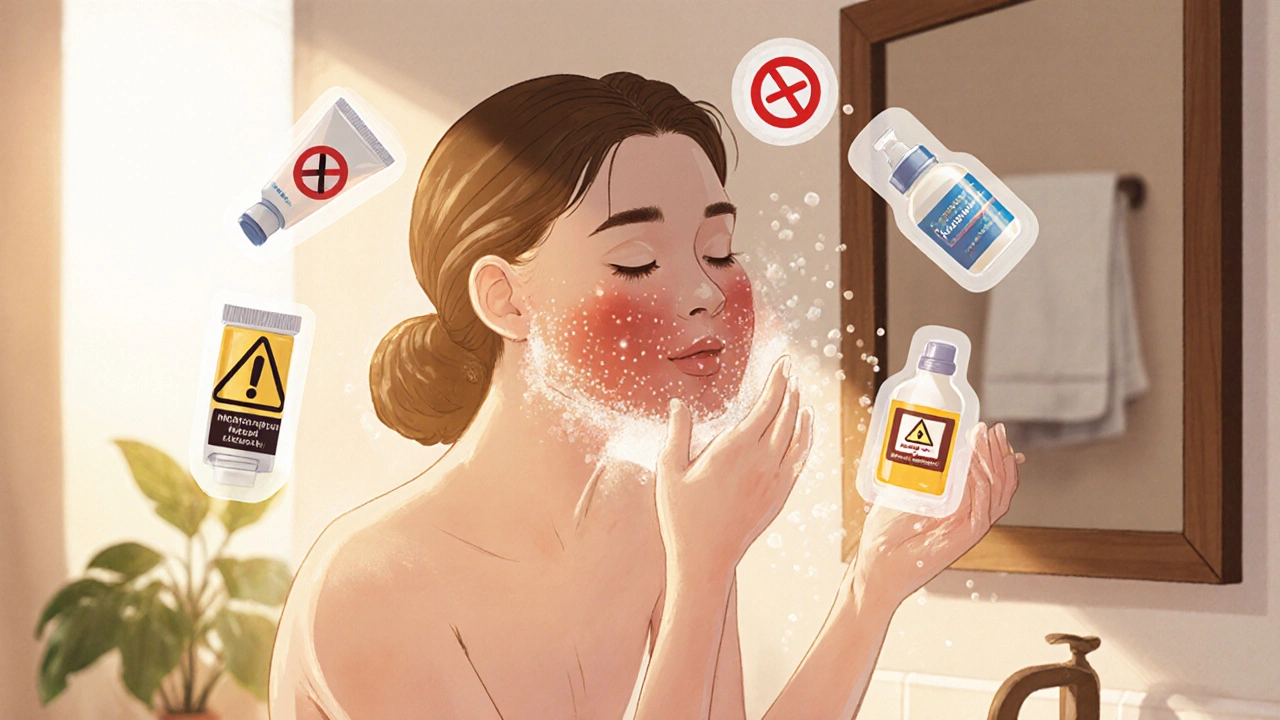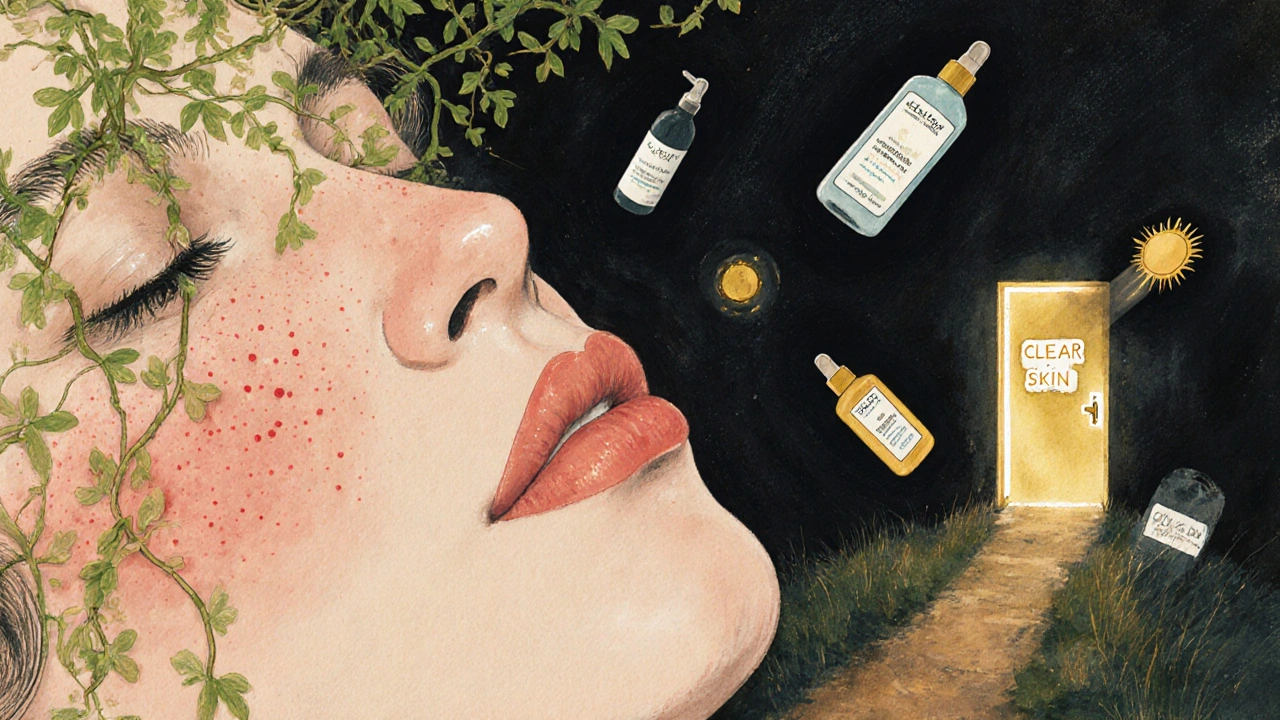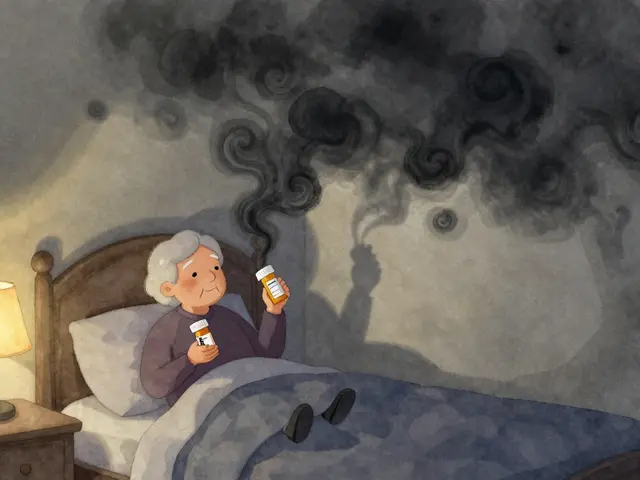
What is perioral dermatitis?
Perioral dermatitis is a red, bumpy rash that forms around the mouth, sometimes spreading to the nose or eyes, but usually leaves the lip border untouched. It looks like acne but doesn't have blackheads or whiteheads. The bumps are tiny-about 1 to 2 millimeters-and often feel burning or itchy. It’s most common in women between 16 and 45, with women being nine times more likely to get it than men. Unlike acne, this isn’t caused by clogged pores. It’s an inflammatory reaction, and while it’s not contagious, it can be persistent and frustrating.
Why does it happen? The real triggers
Most people assume it’s just bad skincare or stress. But the biggest trigger? Topical steroids. About 85% of cases are directly linked to using hydrocortisone cream, steroid creams, or even steroid-containing face products-sometimes for just two weeks. The rash improves at first, then comes back worse when you stop. This rebound effect traps people in a cycle they don’t even realize they’re in.
Other common triggers are hiding in plain sight. Heavy moisturizers with petroleum jelly, dimethicone, or beeswax can clog the skin’s natural barrier and cause flare-ups in nearly half of patients. Even sunscreen can be a problem. Physical sunscreens with zinc oxide or titanium dioxide above 10% concentration trigger reactions in over 20% of cases. That means your "gentle" mineral sunscreen might be making things worse.
Fluoridated toothpaste is another silent culprit. Sodium fluoride at 1,000-1,500 ppm can irritate the skin around the mouth in nearly 4 out of 10 people. Switching to a non-fluoridated brand often leads to noticeable improvement within 4 to 6 weeks.
Hormones play a role too. Over half of women notice their rash flares up before their period, and 28% link it to birth control pills. Environmental factors like wind, sun exposure, and even chewing gum can worsen symptoms. And while not proven to cause it, Demodex mites-tiny organisms that live on skin-are found in 83% of perioral dermatitis cases, compared to just 45% in people without it. Whether they’re the cause or just along for the ride is still debated.
Gentle skin care: Less is more
When you have perioral dermatitis, your skin care routine needs to be stripped down. Most people wash their face twice a day-this is a mistake. Washing too often dries out the skin and makes inflammation worse. In fact, 88% of patients see improvement just by cutting back to once daily.
Your cleanser should be non-foaming, fragrance-free, and pH-balanced (between 5.5 and 6.5). Foaming agents like sodium lauryl sulfate strip the skin. Look for products like Cetaphil Gentle Skin Cleanser or Vanicream Cleansing Bar. Avoid anything labeled "exfoliating," "anti-aging," or "acne-fighting." Those usually contain acids or retinoids that will irritate your skin further.
Moisturizer? Only if you need it. If your skin feels tight, use a light, non-occlusive moisturizer with ceramides between 0.5% and 2% and hyaluronic acid below 1%. Avoid anything thick, greasy, or labeled "intensive repair." Vanicream Moisturizing Cream is a common choice because it’s free of dyes, fragrance, and common irritants.
Sun protection without the sting
You still need sun protection. But heavy mineral sunscreens with high zinc or titanium dioxide levels can trigger flare-ups. Instead, choose a liquid or gel formula with mineral filters below 5% concentration. EltaMD UV Clear Broad-Spectrum SPF 46 (with 4.7% zinc oxide) is frequently recommended by patients and dermatologists alike. If you’re still reacting, try a wide-brimmed hat. Physical barriers are safer than chemical ones when your skin is this sensitive.

Makeup and toothpaste: The hidden traps
Foundation is one of the top cosmetic triggers. Traditional formulas often contain comedogenic ingredients like isopropyl myristate, which clogs pores and inflames the skin. If you must wear makeup, go for fragrance-free, non-comedogenic products with titanium dioxide under 3%. Mineral powders are usually better than liquid foundations.
For toothpaste, switch to a fluoride-free version. Brands like Tom’s of Maine Fluoride-Free or Burt’s Bees Natural Toothpaste are popular choices. Avoid anything with sodium lauryl sulfate (SLS) above 0.1%. SLS is a known irritant and is found in most mainstream toothpastes-even some marketed as "sensitive."
Medical treatments that work
While gentle skin care is the foundation, many people need medical help. Topical antibiotics like metronidazole 0.75% gel work for about 70% of patients after 8 weeks of twice-daily use. Pimecrolimus cream (1%) is another option-it’s non-antibiotic, has fewer side effects, and works for about 65% of users.
For more severe cases, oral antibiotics are used. Doxycycline 40mg modified-release (not the regular 100mg dose) is now preferred. It clears the rash in 85% of patients after 12 weeks, with only 12% reporting stomach upset. The higher 100mg dose has a 45% side effect rate, so it’s rarely recommended anymore.
Treatment takes time. Most people don’t see improvement for at least 3 weeks. The first 7 to 14 days after stopping steroids are often the worst-rash gets redder, itchier, and may even spread. This is called "steroid withdrawal," and it’s normal. About 75% of patients experience it. Don’t give up. If you stick with the routine, 85% report major improvement by week 12.
Diet, gluten, and other myths
Some clinics report that 43% of patients improve on a gluten-free diet-especially those with known gluten sensitivity. But this isn’t universal. Cleveland Clinic says dietary changes only help about 12% of unselected cases. So don’t go gluten-free unless you have a clear reaction. Test it for 6 weeks. If nothing changes, it’s probably not the issue.
There’s no strong evidence that dairy, sugar, or alcohol directly cause perioral dermatitis. But if you notice your rash flares after eating certain foods, keep a journal. Individual triggers vary.

What not to do
- Don’t use steroid creams-even over-the-counter hydrocortisone. It’s the #1 trigger.
- Don’t scrub, exfoliate, or use acids (glycolic, salicylic, lactic).
- Don’t use retinoids, vitamin C serums, or essential oils.
- Don’t wash your face more than once a day.
- Don’t assume "natural" or "organic" means safe. Many natural oils (like coconut or tea tree) are too heavy and irritating.
How long until it clears?
Most people see improvement in 4 to 8 weeks, but full clearance often takes 6 to 12 weeks. Stopping treatment too early is the #1 reason it comes back. Up to 60% of cases return if you don’t finish the full course of antibiotics or go back to old habits.
Once it’s gone, keep your routine simple. Use the same gentle cleanser and moisturizer. Avoid steroids forever. Reintroduce products slowly-one at a time-and watch for reactions. If your skin stays clear for 3 months, you’re likely in the clear.
Recurrence is common-but preventable
Without proper trigger management, recurrence rates are 40-60%. But with consistent gentle care and trigger avoidance, that drops to 25%. The key isn’t finding the perfect product-it’s learning what *not* to use.
People who succeed are the ones who stick with the basics: one gentle cleanser, one light moisturizer, no steroids, no fluoride toothpaste, and patience. It’s not glamorous. But it works.
Can perioral dermatitis go away on its own?
Sometimes, but rarely without changes to your routine. If you keep using steroids, heavy moisturizers, or fluoride toothpaste, the rash will likely return. Most people need to stop triggers and follow a gentle skin care plan to see real improvement.
Is perioral dermatitis the same as acne?
No. Acne has blackheads and whiteheads and is caused by oil and bacteria in pores. Perioral dermatitis has tiny red bumps without comedones, appears around the mouth (not the forehead or back), and is triggered by irritation or steroids-not oil production.
Why does my rash get worse before it gets better?
If you’ve been using steroid creams, stopping them causes a rebound effect. Your skin, used to being suppressed, overreacts. This flare-up can last 7 to 14 days and feels worse than the original rash. It’s temporary. Stick with gentle care-most people see improvement after this phase.
Can I use coconut oil or tea tree oil as a natural remedy?
Avoid them. Coconut oil is highly occlusive and clogs pores. Tea tree oil is a strong irritant, even in diluted form. Both can worsen perioral dermatitis. Natural doesn’t mean safe for sensitive skin.
How do I know if my moisturizer is too heavy?
Check the ingredients. If it contains petroleum jelly, dimethicone, beeswax, lanolin, or mineral oil, it’s too heavy. Look for water-based, lightweight formulas with ceramides under 2%. If your skin feels greasy or tight after 10 minutes, it’s not right.
Should I see a dermatologist?
Yes, especially if the rash doesn’t improve after 4 weeks of gentle care or if it spreads to your eyes. A dermatologist can confirm the diagnosis and prescribe the right treatment-like metronidazole or low-dose doxycycline-based on your specific case.






Erika Lukacs
November 16, 2025 AT 09:29It’s wild how something so small-like toothpaste-can wreck your whole face. I never thought fluoride could be the culprit. I switched to a non-fluoride brand after reading this and my rash faded in three weeks. No magic, just dumb luck with ingredients.
Turns out, the real villain isn’t stress or hormones. It’s the stuff we’re told is ‘good for you.’
Rebekah Kryger
November 16, 2025 AT 22:07Let’s be real-this is just modern medicine’s way of monetizing skin anxiety. You don’t need to avoid ‘occlusive’ moisturizers. You need to stop consuming fear-based skincare content. Your skin isn’t a lab experiment. It’s a barrier. It evolved to handle dirt, sweat, and yes-petroleum jelly.
They’re selling you a routine to replace the one they just told you was toxic. Classic bait-and-switch.
Rodney Keats
November 17, 2025 AT 18:22So let me get this straight. You’re telling me the solution to a rash is to stop using steroids… and also stop using moisturizer… and also stop using toothpaste… and also stop using sunscreen… and also stop using makeup?
Wow. So basically, I just have to become a hermit who only licks water off rocks. Got it.
Laura-Jade Vaughan
November 19, 2025 AT 09:22OMG I’M SO GLAD I FOUND THIS 🥹 I literally cried when I switched to Tom’s fluoride-free toothpaste. My face looked like a tomato for 2 weeks after ditching the hydrocortisone but now?? 🌸✨ My skin is literally glowing. I even started using Vanicream and it’s like my face finally said ‘thank you’.
Also, Demodex mites?? Are we being eaten alive?? 😱 I now sleep with a face mask on. Just in case.
Jennifer Stephenson
November 19, 2025 AT 11:19Stop steroids. Wash once a day. Use gentle products. Avoid fluoride toothpaste. That’s it.
Simple. Not easy. But simple.
Segun Kareem
November 20, 2025 AT 14:39Listen-your skin is not broken. It’s just been betrayed. You were told to ‘treat’ it with chemicals, and now it’s screaming for peace. This isn’t a disease. It’s a rebellion.
Stop fighting your skin. Start listening. The answer isn’t in a bottle. It’s in silence. Less product. Less noise. Less fear.
Let your skin breathe. It remembers how to heal. You just forgot to let it.
Philip Rindom
November 21, 2025 AT 00:44Okay, I’ll admit-I used hydrocortisone for my ‘redness’ for like 6 months. Didn’t realize it was making it worse. This post basically saved my face.
Switched to Cetaphil and Vanicream. No makeup for 3 weeks. Non-fluoride toothpaste. And yeah, the first two weeks were hell. But now? Clear. No drama.
Also, I totally thought coconut oil was a miracle. Nope. Worst idea ever. 😅
Jess Redfearn
November 21, 2025 AT 07:32Wait, so if I stop using steroid cream, my face gets worse? Like… for real? How long does that last? Can I still use aloe vera? What if I just rub my face with ice? Does that help? I need to know everything now.
Ashley B
November 23, 2025 AT 02:15THIS IS A BIG PHARMA SCAM. They invented ‘perioral dermatitis’ so you’d buy their ‘gentle’ products. Hydrocortisone is safe. They just don’t want you using it because it’s cheap. Vanicream? Made by a company owned by Johnson & Johnson. They’re the same ones who sold you the steroid cream.
Demodex mites? That’s a lie. It’s just your immune system reacting to corporate toxins in your water. Fluoride is a mind control chemical. Stop drinking tap water. Start filtering. And never trust dermatologists. They’re paid by Big Skin.
Scott Walker
November 24, 2025 AT 18:09Just wanted to say… I’ve had this for 3 years. Tried everything. This post? The first one that made sense.
Switched to EltaMD UV Clear. No more burning. No more redness. I even stopped washing my face every night. Just water in the AM. My skin is… okay. Not perfect. But okay.
Thanks for not being a sales pitch. 🙏
Sharon Campbell
November 25, 2025 AT 09:29so like... uhh... i stopped using my cream and now my face is on fire? is that normal? i thought this was gonna be easy. also i used coconut oil because it's natural and now i'm scared. pls help.
sara styles
November 25, 2025 AT 15:04Let me break this down for you because most people are too dumb to read past the first paragraph. This isn’t about ‘gentle skincare.’ This is about systemic inflammation triggered by endocrine disruptors embedded in consumer products. Fluoride isn’t just in toothpaste-it’s in your water, your tea, your bread. And guess what? The FDA knows. They’ve known since 1998. The mite theory? A distraction. It’s not Demodex. It’s glyphosate. It’s parabens. It’s microplastics in your moisturizer.
You think stopping steroid cream is the solution? No. You need to detox your entire environment. Buy organic. Filter your water. Stop using plastic containers. Wear a mask when you shower. And if you’re still using ‘Vanicream’? You’re still being manipulated. It’s still got trace sulfates. Read the full ingredient list. I’ve got a 12-page PDF on this. Want it?
Brendan Peterson
November 26, 2025 AT 18:40Interesting breakdown. The 85% steroid link is well-documented in dermatology journals from 2015–2022. The fluoride toothpaste connection is less consistent but supported in three small cohort studies. The Demodex correlation is strong, but causality remains unproven. I’d add that low-dose doxycycline (40mg) is now in the 2023 AAD guidelines as first-line for moderate-to-severe cases.
Also, ‘non-occlusive’ doesn’t mean ‘water-based.’ Some silicones are non-occlusive. Dimethicone at <1% is fine. It’s the high-concentration waxes that are the issue.